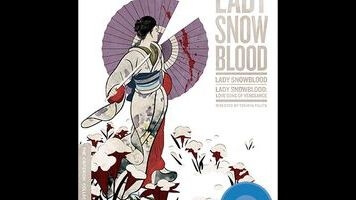A Tarantino-approved classic gets vibrant new life in The Complete Lady Snowblood

A pulpy, violent tale of revenge based on a comic serialized in a popular Playboy-esque men’s magazine, Lady Snowblood didn’t have to be art. But director Toshiya Fujita treated it as such, utilizing a complicated flashback structure and expressionistic cinematography to tell the story of Yuki Kashima, a highly skilled assassin trained from birth to find and kill the men (and woman) responsible for murdering her father and raping her mother before she was born. Her nickname, shurayukihime (“carnage snow princess”), is a pun on the Japanese name for Snow White, shirayukihime (“white snow princess”), reflecting her cold, grim beauty. Yuki found her ideal embodiment in Meiko Kaji, early icon of female action stardom and ultimate ice queen, whose huge, deep-set eyes reflect both burning hatred and heartbreaking reluctance. Elegantly dispatching her enemies with a flick of the wrist amid fountains of tempera-paint blood spray—this is one of those movies where blood doesn’t run or drip, it sprays—she’s both human and divine.
Kaji was something of an anomaly in the studio-centric Japanese film scene of the early ’70s. She was in her early 20s when she became famous for starring in the Stray Cat Rock series of juvenile delinquent movies for Nikkatsu, two of which were directed by Fujita. In 1971, she jumped ship for Toei Studios, for whom she played another semi-divine assassin in the Female Prisoner Scorpion movies. She changed studios once again, to Toho, to reunite with Fujita for Lady Snowblood. But while “goddess of revenge” was very much Kaji’s wheelhouse by 1973, Fujita was primarily known as a director of movies about restless youth, and had to be talked into helming this deathly serious grand guignol of karmic carnage.
Most Westerners—this writer included, who saw it for the first time in 2003—know Lady Snowblood thanks to its connection to Kill Bill, Vol. 1, which borrows extensively from Fujita’s film in its plot, themes, cinematography, and soundtrack. (“Shura No Hana,” the theme from Lady Snowblood as sung by Kaji herself, plays over the end credits of Tarantino’s film, for example, and Kill Bill lifts several shots from the earlier film verbatim.) The character of O-Ren Ishii is also clearly inspired by Yuki, and both films, not-so-coincidentally, end with a violent confrontation in the snow.
Less familiar are the films’ political and historical contexts, which would be familiar to the average Japanese viewer of the ’70s, but foreign to many Westerners. Lady Snowblood takes place at the dawn of the Meiji Era, when Japan opened itself up to trade with the West and, as screenwriter Norio Osada argues in an interview on the special features, lost some of its cultural uniqueness in the process. The gang that destroys Yuki’s family is running a scam tricking ignorant villagers into paying them to avoid a newly instituted national draft, and its leader, Gishiro Tsukamoto (Eiji Okada), becomes a powerful figure in the Westernized Meiji government. By killing them, Yuki is avenging not only her family, but the downtrodden peasants who were exploited in the rush toward modernization.
This anti-authoritarian streak is even more obvious in the sequel, 1974’s Lady Snowblood: Love Song Of Vengeance—the second half of Criterion’s new Blu-ray package. Yuki is caught in the power struggle between the sadistic head of the Secret Police and Ransui Tokunaga (Juzo Itami), a political dissident she is initially hired to kill, but who ultimately converts her to his cause. Having settled her blood grudge in the first film, Yuki is allowed, in Love Song Of Vengeance, to choose her own path—to an extent. The sequel isn’t as compelling as Lady Snowblood, but when it’s not mired down in political moralizing, it’s still enjoyable.
One notable change on the Blu-ray is in the newly translated subtitles. Previous releases of the Lady Snowblood movies referred to Yuki as a “child of hell” or “demon,” but here the translation sticks with the more specific (and difficult to translate) Japanese term “asura.” In Buddhist lore, an asura is a wrathful demigod whose desires can never be slated; Yuki’s desire is for revenge, an endless cycle of violence that can only end in her death. It’s a small but significant change, one that casts the character in a different, more tragic light. This version also omits the additional supertitles included in AnimEigo’s 2004 DVD release, which provided historical notes on events referenced in the plot. Maybe now, in the age of smartphones and Wikipedia, such information is no longer necessary for a home-video release?
Still, some historical context would be nice in the special features, which are sparse. Lady Snowblood: Love Song Of Vengeance only has a trailer, although Lady Snowblood features two interesting new video interviews, one with screenwriter Osada and another with Kazuo Koike, author of the original manga. But the most impressive part of Criterion’s release—and the thing that makes The Complete Lady Snowblood essential for fans of Japanese action cinema—is the new 2K digital restoration, which results in markedly improved brightness and richness of color in both films. Always colorful, here Fujita’s scenes of beautifully composed bloodshed appear positively Sirkian.